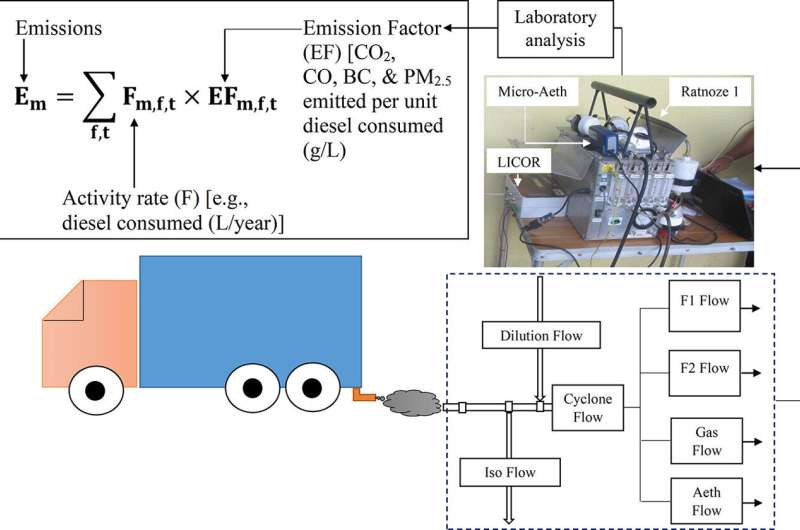Nepal must scrap aging diesel buses and trucks

The rapidly deteriorating air quality in Nepal demands an overhaul of its over a quarter million diesel-powered buses and trucks as well as a drastic revision of the country's vehicles mass emission standards, says a new study.
On the morning of 5 January, the capital, Kathmandu, registered 438 on the Air Quality Index (AQI)—12 times more than the WHO's suggested maximum limit of 35. The composite measurement takes into account particulate matter, carbon monoxide, sulfur, nitrogen dioxide and ozone.
"Using experiment-based emission factors measured on the roadside, we were able to build a comprehensive diesel vehicle emission inventory for the country (Nepal) covering the period from 1989 to 2018," said Bhupendra Das, main study author and researcher at the Institute for Advanced Sustainability Studies, in Potsdam, Germany, and at Tribhuvan University, Kathmandu.
During that period, Nepal's diesel consumption in the transport sector went up 13 times to 892,770 kilolitres annually, according to the study published online last month in Science of the Total Environment.
In building an emissions inventory for Kathmandu, Das and his team encountered large uncertainties due to differing emission factors based on vehicle category, fuel quality and maintenance. "We took into account factors like total distance traveled, fuel consumed, mileage, driving conditions, climatic factors, load and the age of the diesel-powered vehicles that were studied," he said.
The team focused on four major pollutants—carbon monoxide, carbon dioxide, black carbon and PM2.5 (particulate matter smaller than 2.5 microns). The researchers found most diesel-powered buses and other public transport vehicles deployed in Kathmandu are old and poorly maintained. Low vehicle speeds, below 20 kilometers per hour, old vehicles with high mileage, the narrow and hilly roads of the Kathmandu Valley, and poor fuel quality were significant contributors to carbon monoxide and other pollutants.
Fuel quality tests showed that 80 percent of the diesel sampled exceeded the sulfur limits of 350 milligrams per liter as laid down by the public sector Nepal Oil Corporation.
Alok Sagar Gautam, assistant professor at the physics department of the HNB Garhwal University in Uttarakhand state, India, said that while landlocked Nepal imports diesel and other petroleum products from India, "the origins of sulfur and other contaminants in retail fuel are totally different in India and Nepal."
India has ordered the scrapping of all diesel vehicles older than 10 years from the start of the year. Such a drastic move may be difficult for Nepal to follow. But Das suggests a lowering of the present upper limit of 20 years to 15 with emphasis on strict monitoring of older vehicles for emissions.
"Because this study covers both the historical emission factors as well as recent ones, it is valuable for the development of an emission inventory for India and other countries in the South Asia region," Gautam said. "What is needed is a scaled-up project covering the whole region."
Previous studies, such as one published in 2020 in Aerosol and Atmospheric Chemistry, had also shown that poor quality fuel, high traffic congestion, old and poorly maintained diesel vehicles were responsible for a large increase in transport-related emissions in recent years.
The 2020 study found that timely servicing and maintenance of diesel vehicles could lower black carbon emission by 1.4 times and PM 2.5 by almost three times. It recommended a policy of mandatory, routine maintenance of the diesel fleet to systematically reduce emissions in the Kathmandu Valley.
Das suggests a different approach, however. "The present scenario in Kathmandu and in the rest of Nepal, a least-developed country, demands practical, cost-effective solutions to quickly cut emissions. These could start with repair and maintenance of roads, improvement of fuel quality and switching the aging diesel fleet to at least Euro IV standards," he said.
Nepal's nationally determined contribution submitted to the UN Framework Convention on Climate Change envisages promotion of advanced, electric, hybrid, hydrogen-powered, and other types of vehicles running on clean fuels. By 2025 at least 25 percent of all private passenger vehicles sales and 20 percent of all public transport vehicles will be electric-powered, the commitments say.
"The concept of climate-resilient economic growth through an improved transport sector is being taken seriously," said Das. "It is now inescapable that highly polluting and obsolete transport vehicles burning diesel be phased out through scrappage policies that involve compensations or other schemes with incentives for vehicle owners."
More information: Bhupendra Das et al, Emission factors and emission inventory of diesel vehicles in Nepal, Science of The Total Environment (2021). DOI: 10.1016/j.scitotenv.2021.152539
Journal information: Science of the Total Environment
Provided by SciDev.Net




















